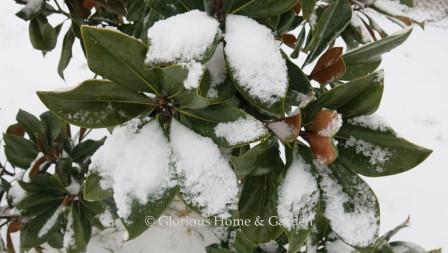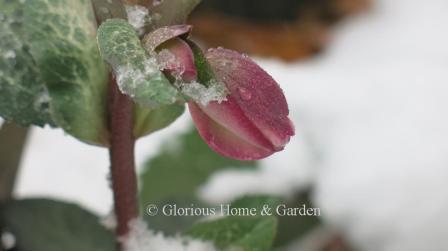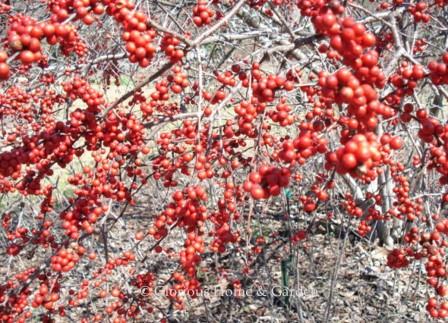- Home
- The Winter Garden
The Winter Garden Can Be As Glorious As Other Seasons!
 Magnolia grandiflora in snow
Magnolia grandiflora in snowThe winter garden is a very special aspect of the gardening year. Everything looks different, everything is fresh. Winter is one of my favorite times of year in the garden. Maybe because I’m a winter baby—born in the midst of January. But winter is not a dead time of year in the garden at all! There is much you can do to bring life, color, interest and beauty to your garden in winter. There are many plants that bloom in the winter in the milder parts of the country. Even if you live in the frozen North, you can still bring the garden indoors with blooming houseplants.
“Winter is the season dominated by bare soil: the whole gardening cycle begins with the care and preparation of the earth during winter so that it will feed plants the following year.”Monty Don
Part of the fun of gardening in the South (I garden in Zone 7b) is that winters are short, the gardening season is long, and there can be things in bloom in the garden almost year around. Of course, the downside is that sometimes plants that begin blooming during a mild spell in late winter—deciduous magnolias, for instance—can be zapped and turned to ugly brown mush by a late freeze. You can bring beauty and interest to your winter landscape with shape and form, evergreens, texture and color of bark, winter bloomers, cones, berries and persistent seedpods. And, of course, don’t forget to attract the beauty and liveliness of songbirds into your garden with bird feeders and with plants that provide food and shelter.
The
winter garden exposes the bones—the design, shape and structure—of the
garden as at no other time of year, so it is important to plan it with
all seasons in mind. Winter is a great time to reassess your garden,
note successes and failures, and make plans. For instance, as you look
upon a bare winter landscape, ask yourself how it could be improved.
Would your winter garden be improved by the addition of some evergreens
for winter color and diversity in the landscape? Consider how you can
improve the winter landscape or the view by careful placement of
evergreens,
or by incorporating,
shrubs or trees that have interesting bark.
persistent berries,
cones or seedpods,
or winter blooms.
Want some flowers for winter color? Nothing beats pansies and violas
(their smaller cousins). Pansies can be planted in the fall (Zone 7 and
above)—they may hunker down when temperatures drop below freezing—but
they will revive with the first hint of warmth and flower until heat
makes them languish (around the end of May in my garden), and then they
can be replaced with summer annuals. Violas seem to be a bit hardier
than pansies and will last longer in the garden. Ornamental cabbages and
kales have been developed with fancy leaf shapes and colors. They are
great in combination with pansies or violas in containers, to border a
walk, or massed in a bed.
The best perennial by far for winter bloom is Helleborus orientalis, or Lenten rose. I absolutely love this plant! Not only are the large leathery palmate leaves handsome all year around, but they bloom in the dead of winter in lovely shades of white, pink, rose and wine (and even some yellows) in solids, or with speckled, edged or mottled patterns. The flowers persist a long time and then fade to green. A favorite variety is called Frostkiss® 'Dorothy's Dawn,’ with mottled silver-veined leaves and upward facing rose-colored blooms that fade to green—an outstanding performer.
 Helleborus x iburgensis Frostkiss® 'Dorothy's Dawn'
Helleborus x iburgensis Frostkiss® 'Dorothy's Dawn'There are some trees and shrubs that provide color in the winter garden. For winter flowering, the glory of southern gardens is the camellia— Camellia sasanqua from mid fall to early winter, and Camellia japonica from late winter to early spring. C. sasanqua is a little more cold-hardy and has smaller leaf and flower than C. japonica. Rosemary is a woody herb that will bloom in winter is milder areas. One of my favorite flowering trees is the 'Okame' cherry (Prunus 'Okame')—heralding the coming of spring in mid-winter. Witchhazels and wintersweet are great choices for winter to early spring color when everything else is bare, in yellow to red varieties. Click here for color for your winter garden with annuals, bulbs, perennials, shrubs and trees.
Click here for a list of evergreen ground covers, shrubs, trees and vines.for your winter garden.
Click here for a list of shrubs and trees with colorful, persistent berries,
For trees and shrubs with interesting cones and persistent seedpods for winter interest, click here.
Click here for a list of trees with interesting bark.
Click here for more information about winter blooming plants.
Click here for more information about winter blooming shrubs.
Click here for more information about winter blooming trees.
Click here for more information about winter blooming camellias.
Plant of the Month

Ilex verticillata
Winterberry holly
Updated new USDA Plant Hardiness Zone Map 2023.